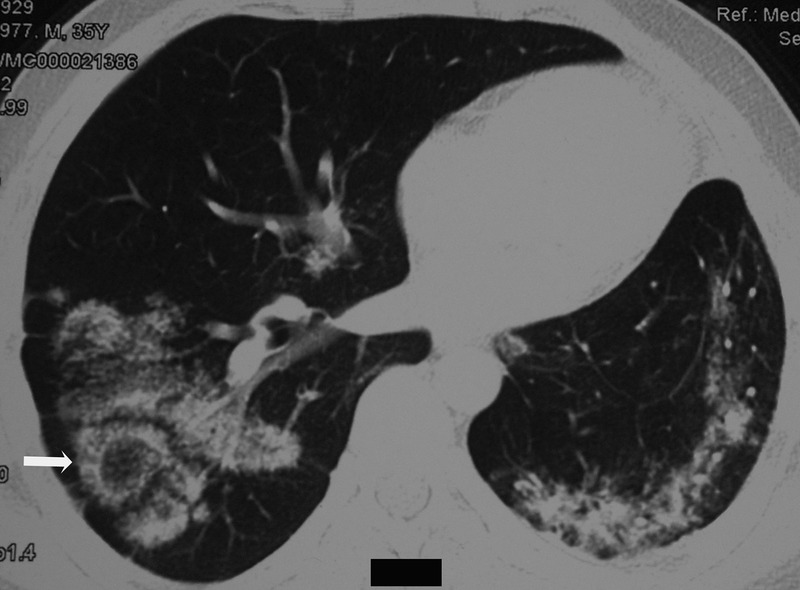Description
A 35-year-old male patient presented with history of fever and cough of 2 months duration. The patient had lost appetite and 8 kg weight over 2 months. On examination of the respiratory system, scattered crackles were audible bilaterally. Rest of the systemic examination was normal. Chest radiograph demonstrated bilateral ill-defined alveolar opacities and left side apical pleural thickening with volume loss (figure 1). CT of the thorax demonstrated multiple complete or incomplete (crescent shaped) nodular areas of consolidation surrounding a region of ground-glass opacity (reversed halo sign) (figure 2). Also seen was left lung volume loss along with compensatory right lung hyperinflation. Sputum examination was positive for acid-fast bacilli (3+) and Sputum GeneXpert MTB/RIF test was positive for Mycobacterium tuberculosis, sensitive to rifampicin. The patient was started on anti-tuberculosis (TB) therapy with four first-line drugs and improved.
Figure 1.

Chest radiograph showing bilateral ill-defined alveolar opacities and left side apical pleural thickening. Signs of volume loss are seen on the left side (trachea is deviated to the left side and the left hemi-diaphragm is elevated).
Figure 2.

CT of the thorax showing reversed halo sign (white arrow), an area of near complete consolidation surrounding a region of ground-glass opacity. The rim of consolidation is nodular in appearance and a few nodules are also seen inside the central halo. There is lung volume loss on the left side and the right lung showing compensatory hyperinflation.
Reversed halo sign (also known as reverse halo sign, atoll sign or fairy ring sign) refers to the appearance of central lucency/ground-glass opacity which is surrounded by the air-space consolidation of crescentic or ring shape on CT of the thorax. Most frequently associated with cryptogenic organising pneumonia (COP), this sign has been reported in a number of conditions like invasive pulmonary fungal infections, pneumocystis pneumonia, TB, lymphomatoid granulomatosis, granulomatosis with polyangitis, sarcoidosis, pulmonary neoplasm's and infarction, and following radiation therapy/radiofrequency ablation of lung malignancies.1 Presence of nodular walls and presence of nodules inside the halo is an important finding differentiating TB from COP, as was seen in our patient.2
Learning points.
Reversed halo sign refers to the thoracic CT appearance of central lucency/ground-glass opacity, surrounded by the air-space consolidation of crescentic or ring shape.
Reversed halo sign is most commonly associated with cryptogenic organising pneumonia (COP).
Careful recognition of finer aspects of the reversed halo sign like presence of nodular walls and nodules within the central halo is a useful clue to the presence of tuberculosis as the underlying diagnosis.
Footnotes
Contributors: LN, KM and RG were responsible for patient management and manuscript preparation. AB was involved in radiological discussion and manuscript preparation.
Competing interests: None.
Patient consent: Obtained.
Provenance and peer review: Not commissioned; externally peer reviewed.
References
- 1.Madan K, Guleria R. Reverse halo sign. Lung India 2013;30:72–3 [DOI] [PMC free article] [PubMed] [Google Scholar]
- 2.Marchiori E, Zanetti G, Irion KL, et al. Reversed halo sign in active pulmonary tuberculosis: criteria for differentiation from cryptogenic organizing pneumonia. AJR Am J Roentgenol 2011;197:1324–7 [DOI] [PubMed] [Google Scholar]


